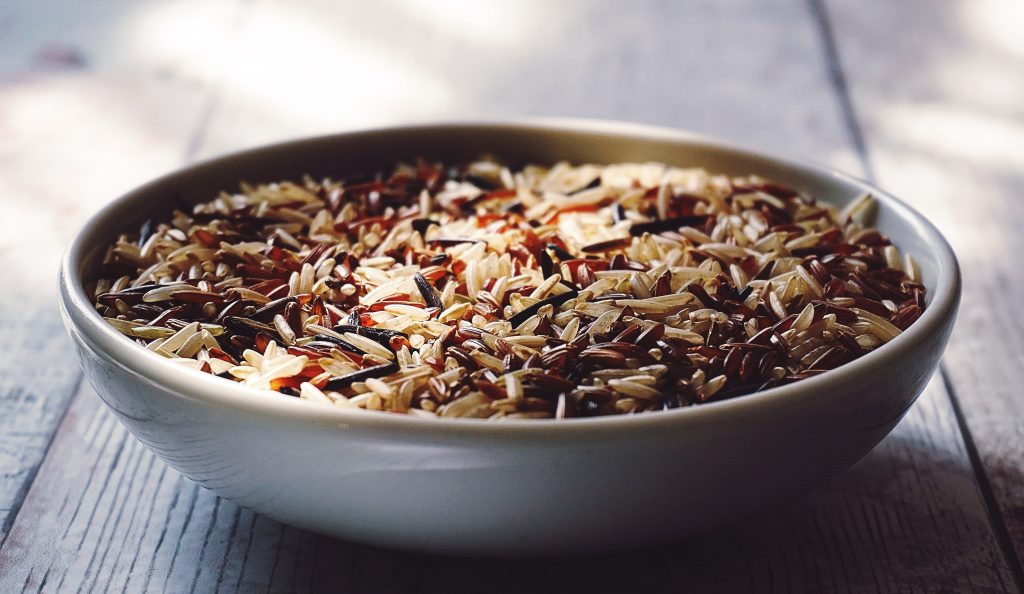Learn about the numerous benefits of incorporating brown rice into your diet.
Discover the Benefits of Brown Rice in Your Diet
Do you crave a nutritious and delicious addition to your diet? Look no further than the humble grain known as brown rice! Packed with essential vitamins and minerals, brown rice offers a range of health benefits that will have you feeling amazing. So, let’s dive into the wonderful world of brown rice and uncover all the reasons why it deserves a prominent place on your plate.
Understanding the Nutritional Value of Brown Rice
When it comes to nutrition, brown rice truly shines. Unlike its refined cousin, white rice, brown rice retains its outer bran layer and germ. This means it’s bursting with essential nutrients such as
fiber, protein, and a variety of vitamins and minerals. Let’s take a closer look at the nutritional benefits of brown rice:

The Essential Vitamins and Minerals in Brown Rice
Brown rice is not only a great source of carbohydrates but also provides a range of essential vitamins and minerals. One of the standout nutrients found in brown rice is vitamin B6. This vitamin plays a crucial role in brain function and helps in the production of neurotransmitters, which are vital for proper brain signaling.
In addition to vitamin B6, brown rice is rich in magnesium. Magnesium is involved in over 300 biochemical reactions in the body and is particularly important for muscle relaxation and contraction. Including brown rice in your diet can help ensure you’re getting enough magnesium to support healthy muscle function.
Another key nutrient found in brown rice is folate, a B-vitamin that is essential for red blood cell production and DNA synthesis. Folate is particularly important during pregnancy as it helps prevent neural tube defects in developing fetuses. Incorporating brown rice into your meals can be a great way to boost your folate intake.
Iron and manganese are two other minerals found in significant amounts in brown rice. Iron is crucial for the production of hemoglobin, the protein responsible for carrying oxygen in the blood. Manganese, on the other hand, plays a role in energy metabolism and acts as an antioxidant, protecting cells from damage caused by free radicals.
The Role of Fiber in Brown Rice
One of the remarkable qualities of brown rice is its high fiber content. Fiber is an indigestible carbohydrate that offers numerous health benefits. In the case of brown rice, the fiber is mainly found in its bran layer. This dietary fiber not only helps keep your digestive system running smoothly but also contributes to maintaining stable blood sugar levels.
By slowing down the absorption of glucose into the bloodstream, the fiber in brown rice helps prevent rapid spikes in blood sugar levels. This can be particularly beneficial for individuals with diabetes or those looking to manage their blood sugar levels more effectively.
Furthermore, the fiber in brown rice adds bulk to your diet, promoting a feeling of fullness and aiding in weight management. If you’re trying to lose weight or maintain a healthy weight, incorporating brown rice into your meals can help you feel satisfied for longer periods, reducing the likelihood of overeating.
In conclusion, brown rice is not only a delicious and versatile grain but also a nutritional powerhouse. Its rich content of essential vitamins, minerals, and fiber makes it a valuable addition to any balanced diet. Whether you’re looking to support brain function, maintain stable blood sugar levels, or manage your weight, brown rice can be a fantastic choice to meet your nutritional needs.
The Health Benefits of Incorporating Brown Rice into Your Diet
Now that we’ve explored the nutrients hiding within each grain of brown rice, let’s take a closer look at the specific health benefits it offers.
Brown rice, a whole grain that is less processed than white rice, is not only delicious but also packed with nutrients that can contribute to your overall well-being. In addition to being a versatile ingredient in various dishes, brown rice offers numerous health benefits that make it an excellent choice for a balanced diet.
Brown Rice and Heart Health
Studies have suggested that including brown rice in your diet may reduce the risk of heart disease. The combination of fiber, antioxidants, and healthy fats found in brown rice can help lower cholesterol levels and regulate blood pressure, leading to a healthier heart.
Fiber, a key component of brown rice, plays a crucial role in maintaining heart health. It helps remove excess cholesterol from the body, preventing it from clogging the arteries and reducing the risk of heart attacks and strokes. Antioxidants, such as selenium and phenolic compounds, found in brown rice also contribute to heart health by neutralizing harmful free radicals and reducing inflammation in the cardiovascular system.
Brown Rice and Digestive Health
Thanks to its high fiber content, brown rice supports a healthy digestive system. Fiber aids in preventing constipation and promotes regular bowel movements, keeping your gut happy and your digestion in check.
The fiber in brown rice adds bulk to the stool, making it easier to pass through the intestines. This not only prevents constipation but also helps maintain a healthy balance of gut bacteria. A healthy gut microbiome is essential for optimal digestion and nutrient absorption. Additionally, the fiber in brown rice acts as a prebiotic, providing nourishment for beneficial bacteria in the gut, which further supports digestive health.
Brown Rice and Weight Management
Are you on a quest to shed a few extra pounds? Brown rice is an ideal addition to your weight loss journey. It provides a satisfying feeling of fullness, preventing overeating. Additionally, the complex carbohydrates found in brown rice are digested more slowly than simple carbs, keeping you feeling energized and focused throughout the day.
When it comes to weight management, the fiber content in brown rice plays a significant role. It slows down the digestion process, allowing for a gradual release of glucose into the bloodstream. This helps stabilize blood sugar levels and prevents sudden spikes and crashes in energy. The slow digestion of complex carbohydrates also keeps you feeling fuller for longer, reducing the temptation to snack on unhealthy foods between meals.
Furthermore, brown rice is a low-calorie food that can be incorporated into a calorie-controlled diet. By substituting white rice with brown rice, you can reduce your calorie intake without compromising on taste or nutrition.
Debunking Myths about Brown Rice
Despite its numerous health benefits, brown rice has been the subject of some misconceptions. Let’s delve into these myths and set the record straight once and for all.
Brown rice, with its earthy flavor and chewy texture, has gained popularity in recent years as a healthier alternative to white rice. However, there are still lingering doubts and questions surrounding its nutritional value and potential risks. In this article, we will explore some common myths about brown rice and provide evidence-based information to debunk them.
Brown Rice vs. White Rice: Which is Healthier?
There’s an ongoing debate about whether brown rice is superior to white rice. While both have their merits, brown rice takes the lead in terms of nutritional value. White rice loses most of its nutrients during the refining process, leaving behind a stripped-down version lacking in fiber and essential vitamins.
Unlike white rice, brown rice retains its bran and germ layers, which are rich in fiber, antioxidants, and various nutrients. These components contribute to a slower digestion process, helping to regulate blood sugar levels and promote satiety. Additionally, the higher fiber content in brown rice aids in maintaining a healthy digestive system and preventing constipation.
Moreover, brown rice contains higher levels of essential minerals such as magnesium, phosphorus, and selenium compared to white rice. These minerals play crucial roles in bone health, energy metabolism, and antioxidant defense.
Addressing Concerns about Arsenic in Brown Rice
Anxiety about arsenic levels in brown rice has occasionally caused concern among health-conscious individuals. Rest assured that consuming moderate amounts of brown rice won’t put you at risk. Brown rice from reputable sources is generally safe to enjoy, and soaking it before cooking can further reduce any potential arsenic content.
Arsenic is a naturally occurring element found in soil, water, and air. It can be absorbed by plants, including rice, from the environment. However, the concentration of arsenic in rice varies depending on factors such as cultivation practices, soil conditions, and water sources.
While it is true that brown rice tends to have slightly higher levels of arsenic compared to white rice, the difference is minimal and not significant enough to pose a health risk when consumed in moderation. The key is to choose high-quality brown rice from trusted sources and diversify your grain intake to minimize any potential exposure to arsenic.
Soaking brown rice before cooking can also help reduce arsenic levels. By rinsing the rice and soaking it for a few hours, you can effectively remove some of the arsenic content. Additionally, cooking rice with a higher water-to-rice ratio and draining the excess water can further reduce arsenic levels.
It’s important to note that the benefits of consuming brown rice outweigh the potential risks associated with arsenic. The nutritional value and fiber content of brown rice make it a valuable addition to a balanced diet, promoting overall health and well-being.
Practical Ways to Include Brown Rice in Your Meals
Now that we’ve covered the many reasons why brown rice is a nutritional superstar, you might be wondering how to incorporate it into your daily meals. Fear not! Here are some practical tips and delicious recipes to make brown rice a staple in your kitchen.
Cooking Tips for Perfect Brown Rice
Cooking brown rice to perfection can be a bit tricky. However, with a few simple tips, you’ll achieve fluffy, tender grains every time. Firstly, rinse the rice thoroughly before cooking to remove any excess starch. Secondly, use a ratio of 2 cups of water for every cup of brown rice. Finally, let it rest for a few minutes after cooking to allow the steam to distribute evenly before fluffing it with a fork.
Delicious and Healthy Brown Rice Recipes
Eating healthy doesn’t have to be boring! Spice up your meals with mouthwatering brown rice recipes. From colorful stir-fried vegetables with brown rice to creamy coconut milk brown rice pudding, there’s something for every taste bud. Get ready to explore a whole new world of flavors and textures!
The Environmental Impact of Choosing Brown Rice
Besides benefiting you and your health, incorporating brown rice into your diet has a positive impact on the environment.

How Brown Rice Farming Affects the Environment
Compared to other types of rice, brown rice requires less water and fertilizer for cultivation. By choosing brown rice, you’re supporting sustainable farming practices that minimize the strain on our planet’s precious resources.
The Sustainability of Brown Rice Production
With the rising awareness of environmental issues, it’s essential to opt for food choices that align with sustainability goals. Brown rice production contributes to preserving biodiversity, reducing carbon emissions, and ensuring a healthier planet for future generations.
In conclusion, adding brown rice to your diet is a wise and delicious choice. Bursting with essential vitamins and minerals, brown rice supports heart health, aids digestion, assists in weight management, and offers a sustainable alternative to refined grains. So, be adventurous in the kitchen and embrace the magic of brown rice. Your taste buds, body, and the environment will thank you!







